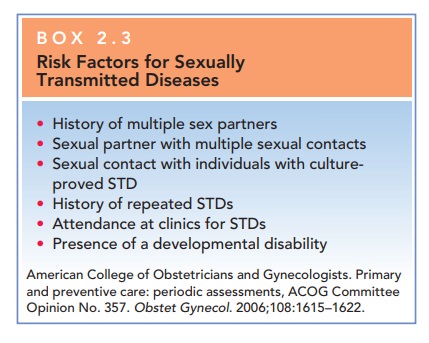Chapter: Obstetrics and Gynecology: The Obstetrician-Gynecologist’s Role in Screening and Preventive Care
Chlamydia Infection
CHLAMYDIA INFECTION
Infection caused by Chlamydia trachomatis is the most commonly reported bacterial STD in the United States. Over one million cases were reported to the CDC in 2006, and it is estimated that another 1.7 million cases go un-diagnosed. If untreated, chlamydia can cause significant long-term complications, including infertility, ectopic pregnancy, and chronic pelvic pain. Diagnosing chlamy-dia promptly is necessary to prevent these complications. Sexually active women 25 years of age and younger should re-ceive annual screening for chlamydia. Asymptomatic women aged 26 and older who are at high risk for infection should be routinely screened. Nucleic acid amplification tests (NAATs)of endocervical swab specimens can identify infection in asymptomatic women with high specificity and sensitivity. NAATs of vaginal swabs and urine samples have compa-rable sensitivity and specificity.
Gonorrhea Infection
Of the estimated 700,000 new
cases of gonorrhea annu-ally, less
than half are reported. Infection can be symp-tomatic with cervicitis and
vaginal discharge, or it may be asymptomatic. Gonorrhea may lead to pelvic
inflam-matory disease, which is associated with long-term mor-bidity due to
chronic pelvic pain, ectopic pregnancy, and infertility.
ACOG recommends screening of
women based on risk factors. Asymptomatic
women aged 26 and older should receive routine screening if they are at high
risk for infection. All sexu-ally active adolescents should also be
routinely screened. Screening can be done by cervical cultures or by newer
techniques such as NAATs and nucleic acid hybridization tests that have better
sensitivity with comparable specificity.
Syphilis
Syphilis is not a
common disease in the United States,but the rate has increased over the last
few years. Almost 10,000 cases were diagnosed in 2006, which translates into a
rate of 1 case of primary or secondary syphilis per 100,000 women.
Syphilis is a systemic disease
caused by the bacteria Treponema
pallidum. If untreated, syphilis may progressfrom a primary infection
characterized by a painless ulcer (chancre), to secondary and tertiary
infections. Signs and symptoms of secondary infection include skin
manifesta-tions and lymphadenopathy; tertiary infection may cause cardiac or
ophthalmic manifestations, auditory abnormal-ities, or gummatous lesions.
Serologic tests may be nega-tive in the early stages of infection.
ACOG recommends
annual syphilis screening for women at increased risk (see Box
2.3). All pregnant women shouldbe serologically screened as early as possible
in pregnancy and again at delivery. Due to the possibility of a false-negative
result in early stages of infection, patients who are considered at high risk
or who are from areas of high prevalence should be retested at the beginning of
the third trimester.

Screening includes initially
nontreponemal tests such as VDRL (Venereal Disease Research Laboratory) or
rapid plasma reagin (RPR). These tests are followed by confir-matory treponemal
tests such as T. pallidum particle
agglu-tination (TP-PA). The specificity of the nontreponemal tests may be
reduced in the presence of other conditions such as pregnancy, collagen
vascular disease, advanced can-cer, tuberculosis, malaria, or rickettsial
diseases.
Related Topics